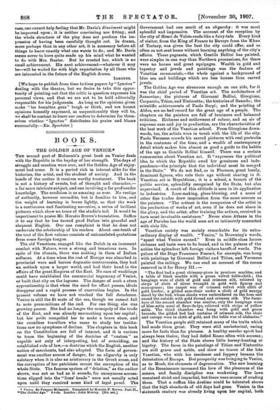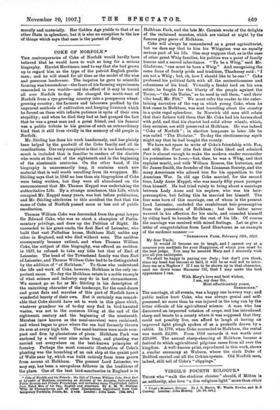13 0 0 K S.
THE GOLDEN AGE OF VENICE.•
THE second part of Molmenti's great book on Venice deals with the Republic in the heyday of her strength. The days of struggle and creation were over, and the Golden Age of enjoy- ment had come. It is a period rich in interest alike for the historian, the artist, and the student of society. And in the hands of the author it receives worthy treatment. The book is not a history of events, but of thought and character,— a far more intricate subject, and one involving a far profounder knowledge. The erudition is as amazing as ever. No vestige of authority, however recondite, but is familiar to him, and the weight of learning is borne lightly, so that the work is a continuous and fascinating narrative, a series of brilliant pictures which show no trace of the studio's toil. It would be impertinent to praise Mr. Horatio Brown's translation. Suffice it to say that he has turned good Italian into graceful and eloquent English. Our one complaint is that he does not underrate the scholarship of his readers. About one-tenth of the text of the first volume consists of untranslated quotations from some foreign tongue.
The old Venetians, engaged like the Dutch in an incessant combat with Nature, were a strong and tenacious race. In spite of the climate, there was nothing in them of Italian softness. At a time when the rest of Europe was absorbed in provincial wars and barren dogmatic controversies, they had an outlook upon a larger world, and had their hand in the affairs of the great Empires of the East. No race of weaklings could have established the commercial hegemony of Venice, or built that city on the lagoons. The danger of such a stern apprenticeship is that when the need for effort passes, ideals disappear and a rapid process of enervation begins. In the present volume we have not reached the full decadence. Venice is still the fit mate of the sea, though we cannot fail to note premonitions of the end. For one thing, she was growing poorer. She had no longer the monopoly of the trade of the East, and was already encroaching upon her capital ; but her pride compelled her to make a brave show, and the countless travellers who came to study her institu- tions saw no symptoms of decline. The chapters in this book on the Constitution are full of interest, and it is curious to trace the beginning of the doctrine of "custom" as capable not only of interpreting, but of overriding, an established rule of law,--a doctrine which the English, another nation of merchants, had also adopted. The form of govern- ment was another source of danger, for an oligarchy is only salutary when it is also an aristocracy in the Greek sense, and the corruption of her patriciate meant the corruption of the whole State. The famous system of "deletion," as the author shows, was not so bad as it sounds, for anonymous accusa- tions slipped into the "lions' heads" were not usually acted upon until they received some kind of legal proof. The
• Venice. By Pompoo Mobnenti. Translated by Horatio F. Brown. Part IL, "The Golden Age." 8 vols. London : John Murray. pls. net.]
Government had one merit of an oligarchy : it was most splendid and impressive. The account of the reception by the city of Henri de Valois reads like a fairy-tale. Every kind of visitor, from the King of France to Envoys from the Khan of Tartary, was given the best the city could offer, and as often as not sent home without learning anything of the city's affairs. These pageants, which Gentile Bellini has painted, were simpler in one way than Northern processions, for there were no horses and great equipages. Wealth in gold and tapestry and jewels and paintings was the feature of Venetian ceremonials,—the whole against a background of blue sea and buildings which are less houses than carved jewels.
The Golden Age was strenuous enough on one side, for it was the chief period of Venetian art. The architecture of Sansovino ; the pictures. of Giovanni Bellini, Giorgione, Carpaccio, Titian, and Tintoretto ; the histories of Sanudo ; the
scientific achievements of Paolo Sarpi ; and the printing of Aldus, are no bad record for the great age of a people. Tho chapters on the painters are full of luminous and balanced criticism. Richness and mellowness of colour, and an air of supreme ease and joy in production, are the characteristics of the best work of the Venetian school. From Giorgione down- wards, too, the artists were in touch with the life of the city. Paolo Veronese crowds his sacred pictures with real portraits in the costumes of the time, and a wealth of contemporary detail which makes him almost as good a guide to the habits of the age as 'Gentile Bellini himself. There was a certain communism about Venetian art. It "expresses the political idea to which the Republic owed her greatness and inde- pendence—the principle that the individual must be merged in the State." We do not find, as in Florence, great lonely, dominant figures, who rule their age without sharing ia it. Venetian art is Republican; it is a school, a branch of the public service, splendidly recognised by the State, but also supervised. A result of this attitude is seen in its application to industries. Lace-making, glass-blowing, and a score of other fine trades drew inspiration from the same sources as the painters. "The artisan is the companion of the artist in the production of works of art, even if he does not share in the glory, and the artist, after training the artisan, received iu turn most invaluable assistance." Never since Athens in the age of Pericles has the world seen art so intimately connected with civic life.
Venetian society was mainly remarkable for its extra- ordinary display of wealth. "Venice," in Browning's words, "spent what Venice earned." Even in middle-class homes richness and taste were to be found, and in the palaces of the nobles the splendour left foreign visitors bereft of words. The palace of the Doge Francesco Foscari, for example, was bung with paintings by Giovanni Bellini and Titian, and Veronese painted the ceilings. We can read an account of the rooms reserved in it for Henry III. :—
"The first had a great chimney-piece in precious marbles, and a table of black marble with a green velvet table-cloth ; the hangings were of cloth of gold and crimson silk, relieved by strips of cloth of silver wrought in gold with figures and monograms ; tho carpet was of crimson velvet with croth of gold border; a gilded arm-chair under a cloth of gold -canopy stood by the bed, whose sheets were embroidered on the hem and round the outside with gold thread and crimson silk. The furni- ture of the second chamber was similar, only the hangings were of blue satin sem& of fleur-de-lys, relieved with strips of *yellow satin. The third chamber was hung with gold and green brocade, the gilded bed had curtains of crimson silk, the chair and canopy were in cloth of gold, and the table was of alabaster."
The Venetian people still retained many of the traits which bad made them great. They were still unrhetorical, caring more for facts than for phrases. A healthy secular spirit had always been theirs; they had defied Rome often with success ; and the history of the State shows little heresy-bunting or bigotry. The faces in the paintings of Titian and Tintoretto are still grave and noble, and show no traces of the late Venetian, who with his insolence and foppery became the detestation of Europe. But prosperity was bringing to Venice, as to Moab, the elements of degeneration. The new learning of the Renaissance increased the love of the pleasures of the senses, and family discipline was weakening. The laws remained strict and impartial, but there were means of evading them. That a ruffian like Aretino could be tolerated shows that the high standards of old days had gone. Venice in the sixteenth century was already living upon her capital, both
morally and materially. Her Golden Age yields to that of no other State in splendour, but it is also no exception to the law of things which says that ease is the parent of decay.



















































 Previous page
Previous page